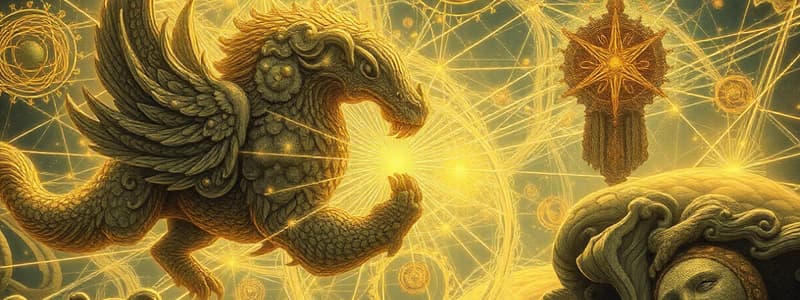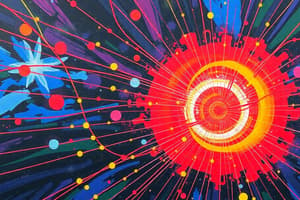Podcast
Questions and Answers
What type of field does a current-carrying conductor produce?
What type of field does a current-carrying conductor produce?
- Only a magnetic field (correct)
- Both electric and magnetic fields
- Neither electric nor magnetic fields
- Only an electric field
What can produce a magnetic field without the presence of a magnet?
What can produce a magnetic field without the presence of a magnet?
- A magnet at rest
- A current-carrying conductor (correct)
- An electric charge at rest
- A stationary compass
Which statement correctly describes the relationship between electric and magnetic fields?
Which statement correctly describes the relationship between electric and magnetic fields?
- An electric field is produced by a moving charge only.
- A charge moving with uniform velocity produces both electric and magnetic fields. (correct)
- A magnetic field requires a current-carrying coil.
- A stationary charge produces a magnetic field.
Which phenomenon is observed when current flows through a wire in a magnetic field?
Which phenomenon is observed when current flows through a wire in a magnetic field?
What type of waves do oscillating or accelerated charges produce?
What type of waves do oscillating or accelerated charges produce?
What direction does the stretched thumb point when fingers of the right hand are curled in the direction of current?
What direction does the stretched thumb point when fingers of the right hand are curled in the direction of current?
In what plane is the current loop positioned according to the description?
In what plane is the current loop positioned according to the description?
What is the effect of the current element idλ in the magnetic field calculation?
What is the effect of the current element idλ in the magnetic field calculation?
What angle is referenced in the equation for the magnetic field at point P?
What angle is referenced in the equation for the magnetic field at point P?
What does the variable R represent in the context described?
What does the variable R represent in the context described?
Flashcards are hidden until you start studying
Study Notes
Magnetism and Electric Charges
- A stationary magnet generates a magnetic field while a stationary electric charge produces an electric field.
- A current-carrying conductor generates a magnetic field, and a charge moving at constant velocity produces both electric and magnetic fields.
- An electric field is dependent on the presence of a charge, while a magnetic field can exist independently of a magnet.
- A current-carrying coil does not create distinct poles. However, it demonstrates magnetic polarity as shown in Oersted's experiment where current in a wire deflects a compass needle.
Electromagnetic Waves
- Oscillating or accelerated charges produce electromagnetic (E.M.) waves alongside electric and magnetic fields.
- The right-hand rule can be applied: if the fingers of the right hand curl in the current's direction, the thumb points in the magnetic field's direction.
Magnetic Field Calculation
- A loop of current flowing counterclockwise in the y-z plane is analyzed for its magnetic field at point P.
- Due to the symmetry of the setup, the magnetic fields contributed by certain segments of the loop can cancel each other out.
- For a long wire near point O, the magnetic field is determined using the Biot-Savart Law: (B_R = \frac{\mu_0 I}{4\pi d}) where (d) is the distance from the wire.
Biot-Savart Law
- This law relates the magnetic field at a point in space to the current generating that field.
- The expression is derived from experimental observations of a magnetic field (dB) generated by an infinitesimal length (d\lambda) of the wire with steady current (I).
- The resultant magnetic field can be calculated using integrals to account for the contributions from all segments of the current-carrying wire.
Practical Application Example
- In a specific configuration of wires carrying current, the magnetic induction at the center can be calculated based on the contributions from each wire and their respective distances from the center.
Studying That Suits You
Use AI to generate personalized quizzes and flashcards to suit your learning preferences.




